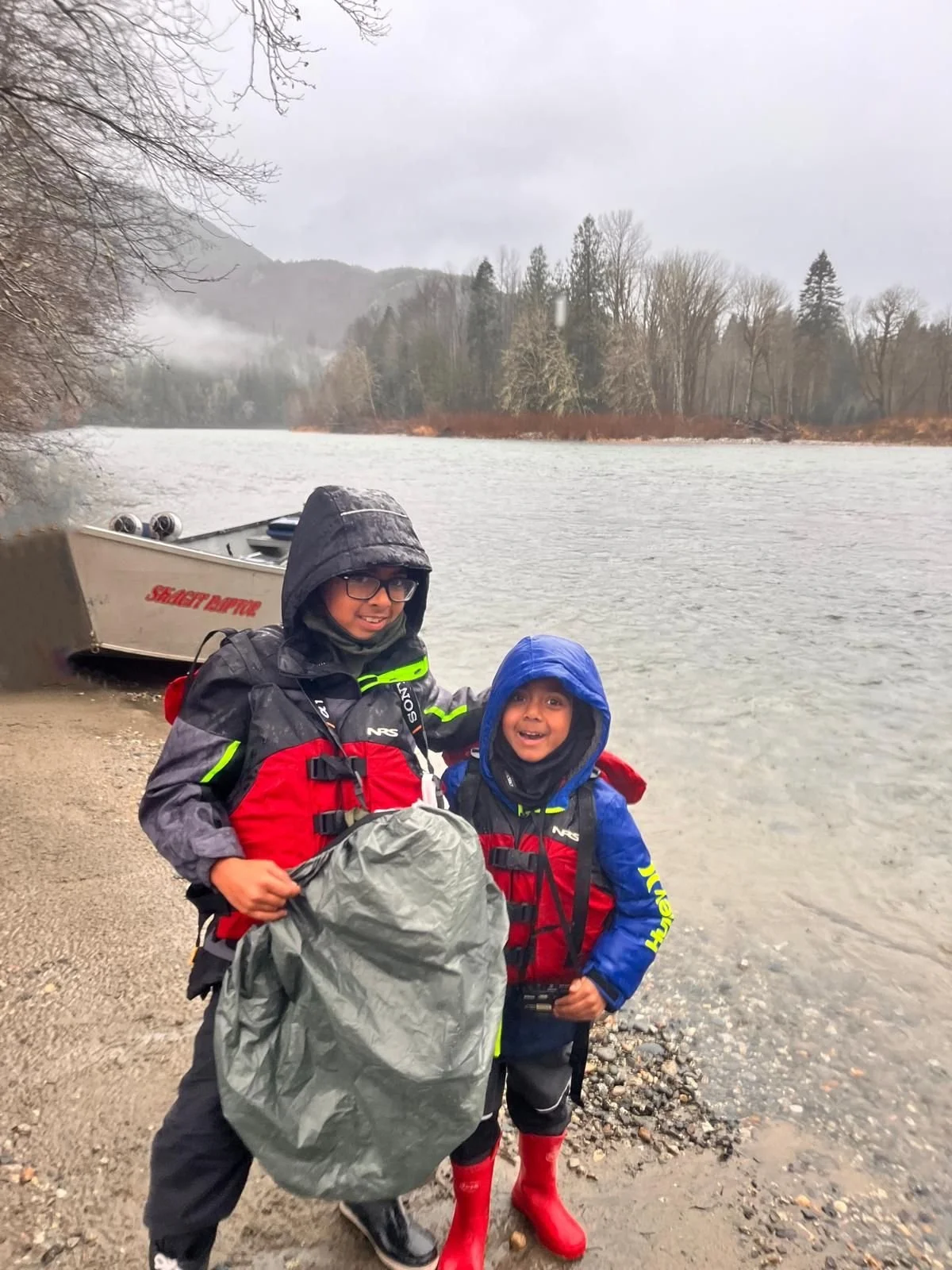Sailing on the Skagit River
As we continued our journey during the winter holidays into Seattle, Washington, I was looking forward to what would become the highlight of our entire trip, a tour on the Skagit River to see the majestic Bald Eagles up close during their migration.
When we got to the meeting place for our boat ride, it was raining hard. Our guide, Will, quickly started explaining that since this was the last Chum Salmon migration of the year, Eagles that had already eaten Chum Salmon up north in other migrations had come down here for a final meal. The Skagit River is special because it is one of the few rivers in the mainland U.S. where you can see all five species of Pacific Salmon all together (Chinook, Coho, Chum, Sockeye, and Pink salmon).
Beautiful Skagit River
Me and My Brother looking forward to spotting the Majestic Bald Eagles on the boat ride of this amazing Skagit River
Let me share with you about the Lifecycle of a Chum Salmon
Chum Salmon Image Credit - https://alaskaoutdoorssupersite.com/chum-salmon
The life of a Chum Salmon starts when it hatches from its egg. It will then stay in the river for two or three weeks, growing 24-30 inches in length and weighing eight to fifteen pounds. They will then swim out into the ocean and will stay there for three to four years. Once that time is done, they will swim against the rapids, swim with all their strength against the river till they return to the place their life started. Isn't it so fascinating that they know the place where their life started and again reach the same surroundings? They will then stay there for two to three weeks.
In that time, they will mate and lay eggs. After that, their life is done and they sacrifice themselves for their young ones, providing vital nutrients to the freshwater ecosystem, enriching the river and supporting other species in the area. I learnt about this during my trip and it took me a minute to register on how a parent sacrifices themselves for the future generation. There is so much in nature that is to learn.
The Bald Eagles migrate every year to feed on the carcesses of the dead Chum Salmon. Bald Eagles start showing up at the Skagit river in late October. The population steadily rises till it reaches its peak in December, particularly Christmas week. The population starts going down through January and into February. By February, most Bald Eagles have left the Skagit River, but there are a few Eagles that stay year-round.
Almost immediately after we got on the boat, we spotted our first eagle, a young juvenile. The way to spot a juvenile is that its head will be brown as opposed to the white head of an adult. There will also be splashes of white around their wings and body. The beak of the juvenile is black as opposed to the yellow beaks of the adult eagles. Older eagles will have faint yellow beaks while young adults will have bright yellow. As we were observing the nature around us, a huge adult soared only a foot above us. Its wingspan was at least six feet wide and it felt that it was almost the size of our boat.
Over the course of the next two hours, we saw approximately 200 Bald Eagles. Our tour guide suggested a game to count and we went along and soon it became such a fun way to keep track of them. I felt magical when I was able to be so close to the majestic and beautiful Bald Eagles. We passed islands where they would be just three feet away from us. They were everywhere, on a tree or on the side of the boat, or soaring above us, or sitting on the banks of the river feeding on the Chum Salmon. It was like our family and the guide had sailed into an Eagle Alley and the pouring rain was the music.
I feel incredibly fortunate to have witnessed this magical moment in nature. To glide along the Skagit River for nine miles, surrounded by the beauty of the landscape, and to see these majestic birds in their natural habitat was a truly awe-inspiring experience. It was a privilege to connect with the wild in such an intimate way, and I will forever treasure the memory of these magnificent creatures in their home.
Capturing the Majestic of An Eagle in Flight.
Perched majestically on a weathered log, the eagle was a picture of grace and power, its feathers ruffled slightly by the breeze. Its piercing eyes scanned the surroundings, alert and ready.
Just as I framed the shot, the eagle spread its wings, preparing for takeoff.When I looked at its eye’s I could see how focussed it was. In that instant, I knew I had to capture the moment of its departure.,despite the pouring rain and the cold weather, where my hands were freezing.
Using a focal length of 280mm and a shutter speed of 1/1000, I aimed to freeze the motion of the eagle's takeoff, capturing the delicate water droplets suspended in mid-air. The wide aperture of f/4.0 allowed for a beautifully blurred background, making the eagle stand out even more.
Positioning the eagle slightly off-cente drawing the viewer's eye into the frame created a balanced composition. The log and the water droplets act as leading lines, towards the majestic bird.
Take Off Ready to Soar the Skies
As we came back to our cabin, we learnt a coincidence. On that same day, the Bald Eagle was officially declared the national bird of the United States Of America. The Skagit River is an amazing place in this world that symbolizes the beauty of nature and how we must save it for the future generations. I would recommend a visit to this hidden gem of a place.
Thank you for reading!



